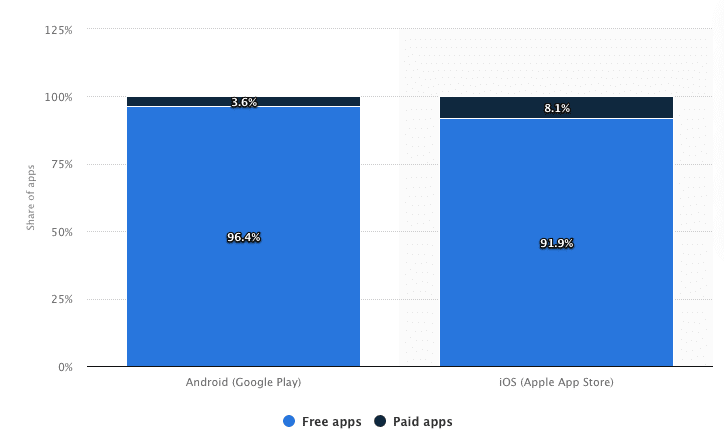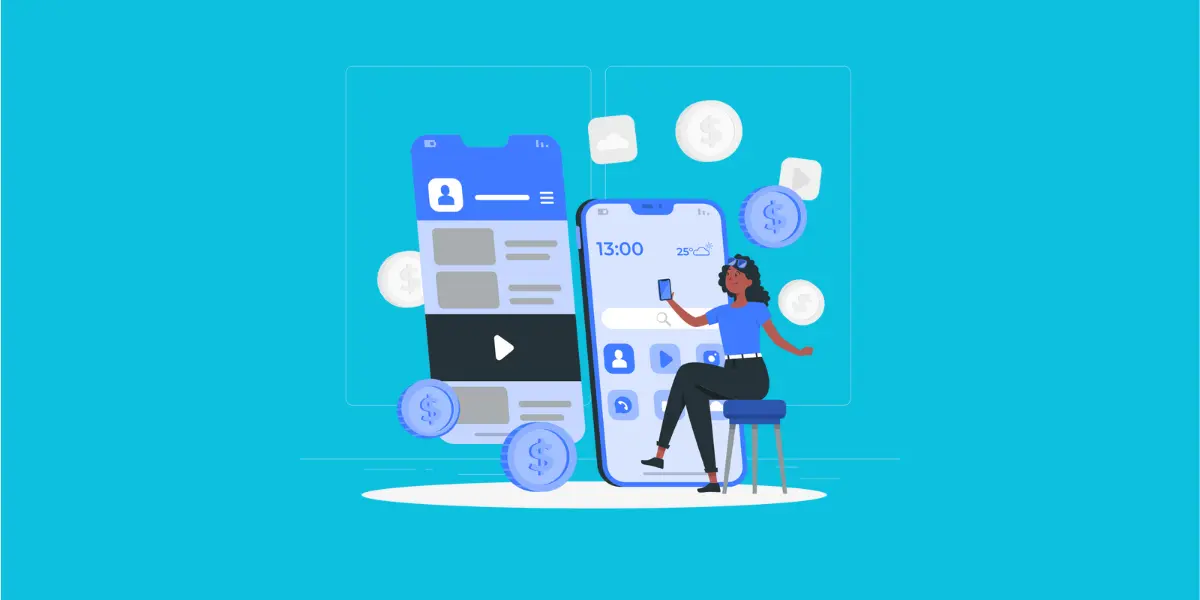Monetization strategies are critical to think through from the very start of mobile app development. There are 8 main strategies that we’ll discuss in this article.
The vast majority of the apps in Google Play, as well as the iOS app store, are free. Only 3.6% are paid apps for Android and 8.1% are paid apps for Apple products. Below are the most recent statistics, provided by Statista, regarding the distribution of free and paid apps in the Google Play and Apple App Store (as of June 2020):

How can those apps be sustainable for the businesses or people that have created them? How can free apps earn money? That’s exactly what we’ll talk about.
What is mobile app monetization?
Mobile app monetization is a way to generate revenue from one’s app. App development isn’t cheap (unless you create an app during your free time when you’re bored), so you need a return on your investment.
One thing to say before we dive into concrete ways and business models for your mobile app is that apps are often created for marketing purposes – the attraction of new customers, retaining existing clients, simplifying the process of using the business services, etc. Therefore, this will not be monetization in a traditional sense, but rather return on investment (ROI).
10 mobile app monetization options
There are many ways you can earn money from your app. In our article, we’ll highlight the most popular ones that will build the foundation for your business model. We aren’t saying that one way is better than another because all businesses are different and you, as the business owner, know your target market and the spending habits of your customers, therefore you are the one who can say which would be the best fit for your business.
The most obvious way to get your investment back is to offer a premium app, i.e. an app that your customers have to purchase after a trial period. Technically, you don’t have to offer a trial but that will get more people from the beginning because fewer people would purchase an app from the start (unless they already know that it’s worth it.)
Get revenue from showing ads
- Interstitial ads – short videos that usually are shown in between levels, for example, or between other logical larger transitions in the app. They usually cover the entire screen of the mobile. Level of annoyance – relatively high, if the levels are short or the ads appear too often with no option to skip them.
- Banners & display ads – shown either at the bottom or top of the screen during the game. Level of annoyance – moderate, unless your users have a mobile device with smaller screens and the ad takes too much space on the screen, making playing the game or using your app very uncomfortable.
- Incentives – short videos that the user has to watch in order to get an advantage (either unique or something that can be otherwise an in-app purchase). Level of annoyance – low, since the user has control over whether they want to see the ad or not, plus s/he gets something useful for the time spent watching the ad.
- Native ads – the ads that are blending in with the game or mobile app’s design and therefore feel natural to the user. These ads require more preliminary thinking through, but they are 20-60% more engaging than other types of ads. The only drawback is that the bounce rate might also be high, compared to other ads because users might not realize at first that they are clicking an ad.
How do these ads drive revenue? There are three types of ad revenue:
- Cost per 1,000 Impressions (CPM, where M is mille i.e. thousand)
- Cost per click (CPC)
- Cost per Action (CPA, also known as conversions)
Cost per impression is usually the most preferred among mobile advertisers because it doesn’t require the user to do anything in order for the publisher to earn money, making it the easiest revenue source.
One of the primary tools to launch such ads on Android is Google AdMob. 81% of the Android top 1000 use this service. It also works on iOS devices (here’s a tutorial on how to set it up.) Other options include Facebook & Instagram marketing platforms, InMobi, and many others.
Provide an option to upgrade to remove ads
We’ve mentioned “level of annoyance” in the ad types above, but even if, for example, native ads aren’t as annoying as other types, they are still ads and many people don’t like to see ads in their apps because they are distracting.
This dislike for ads provides an option for revenue: give your users a chance to upgrade to the ad-less mobile application. The traditional way to do this is to create two apps – one that gets its revenue from advertising and the other earns money from direct downloads and sales.
Offer in-app purchases
In-app purchases (IAP) are additional features that your users might get when they feel the need. There are three types of IAP:
- Subscriptions – for example, when you subscribe to a newsletter app or a service that requires monthly payments.
- Consumable purchases – an extra health point or game currency like gems or armor, for example. These things are sold separately and once you use them up, you need to purchase them again (if the need arises, that is). These are especially loved by various game players because these in-app purchases let them gain an advantage over their opponents.
- Non-consumable purchases – these are the options to remove ads (as we have talked about above), get new features, or unlock bonus levels.
Offer a subscription
You can offer users a subscription to access premium content or additional features for a recurring fee. This model works well for apps that offer ongoing value or services, such as news, music, or fitness apps.
Here are the basic steps involved in implementing a subscription model for a paid mobile app:
- Offer a free trial: Many subscription-based mobile apps offer a free trial period, which allows users to try out the app’s premium features before deciding whether to subscribe. This can be a good way to attract new users and build trust.
- Define subscription tiers: Depending on your app’s features and content, you may offer multiple subscription tiers at different price points. For example, you may offer a basic subscription for access to core features and a premium subscription for access to exclusive content.
- Set up payment processing: To charge users for their subscriptions, you’ll need to set up a payment processing system within your app. This may involve integrating with a third-party payment gateway, such as Apple Pay or Google Pay.
- Manage subscriptions: You’ll need to manage user subscriptions, including handling cancellations, refunds, and billing issues. You may also need to send out regular communications to subscribers, such as notifications about new features or content.
- Monitor and optimize: Once you’ve launched your subscription model, it’s important to monitor user engagement and retention rates. This can help you optimize your pricing, features, and marketing strategies to improve your app’s revenue and user satisfaction.
Join affiliate programs
Affiliate programs aren’t the top popular ways to earn revenue, but they can be quite helpful as well. Major mobile development companies like Google and Apple provide affiliate programs for app developers. To join these programs, you need to pay a commission, but they aren’t usually high (as opposed to some partnerships that might be costly to join).
Find sponsorships
Can your product – mobile game or mobile application – be helpful to other companies? Seek sponsorships from investors who can provide the funds to build the app and make it successful.
Why would someone be interested in sponsoring your app? That’s a good question. One of the value-added benefits you can offer is free marketing within your app (for example, have it branded with “Sponsored by…”)
Mobile marketing is very powerful and it gains traction more and more since around 80% of people around the world have access to mobile phones. Your iOS or Android app could be someone’s marketing opportunity.
Collaborate with other companies
Collaboration with other companies is similar to sponsorship opportunities we talked about before, but this is more on the technical side of things. Your app can be created in conjunction with other developers or companies to promote both your app and its products.
For example, if you have a travel app, you can promote their flight-searching service. If you have a fitness app, you can promote various band albums up for purchase on iTunes, etc.
Data Monetization
Data monetization involves collecting and analyzing user data and selling it to third-party companies for market research or advertising purposes. While data monetization can be a lucrative revenue stream for mobile app developers, it’s important to handle user data ethically and transparently to protect users’ privacy.
Here are some types of mobile apps that may benefit from data monetization:
- Social media apps: Social media apps collect vast amounts of user data, including demographics, interests, and online behavior. This data can be valuable to advertisers who want to target specific audiences with their ads.
- Fitness and wellness apps: Fitness and wellness apps often collect user data such as exercise habits, sleep patterns, and nutrition information. This data can be valuable to health and wellness companies for research and product development.
- Travel and transportation apps: Travel and transportation apps collect data on user locations, travel patterns, and preferences. This data can be valuable to advertisers and transportation companies who want to improve their services and target potential customers.
- Shopping and e-commerce apps: Shopping and e-commerce apps collect user data such as purchase history, browsing behavior, and product preferences. This data can be valuable to retailers who want to improve their marketing strategies and product offerings.
- News and media apps: News and media apps collect user data such as reading habits, interests, and demographics. This data can be valuable to publishers and advertisers who want to tailor their content to specific audiences.
Bonus: Combine the options
We’ve mentioned above that no one knows your business better than you. You know the things your potential customers can react to as well as their ad preferences. Therefore, you don’t have to stick to a single business model described above, but instead, combine a couple to reach maximum traction and benefits for everyone involved.
Free app or paid app?
As you can see, investing in mobile app development is a risky thing (as are all investments), but at the same time, you can get a good return on investment if you implement app monetization options into your mobile app or game.
Book a call with our experts
Feel free to drop us a message regarding your project – we’re eagerly looking forward to hearing from you!


